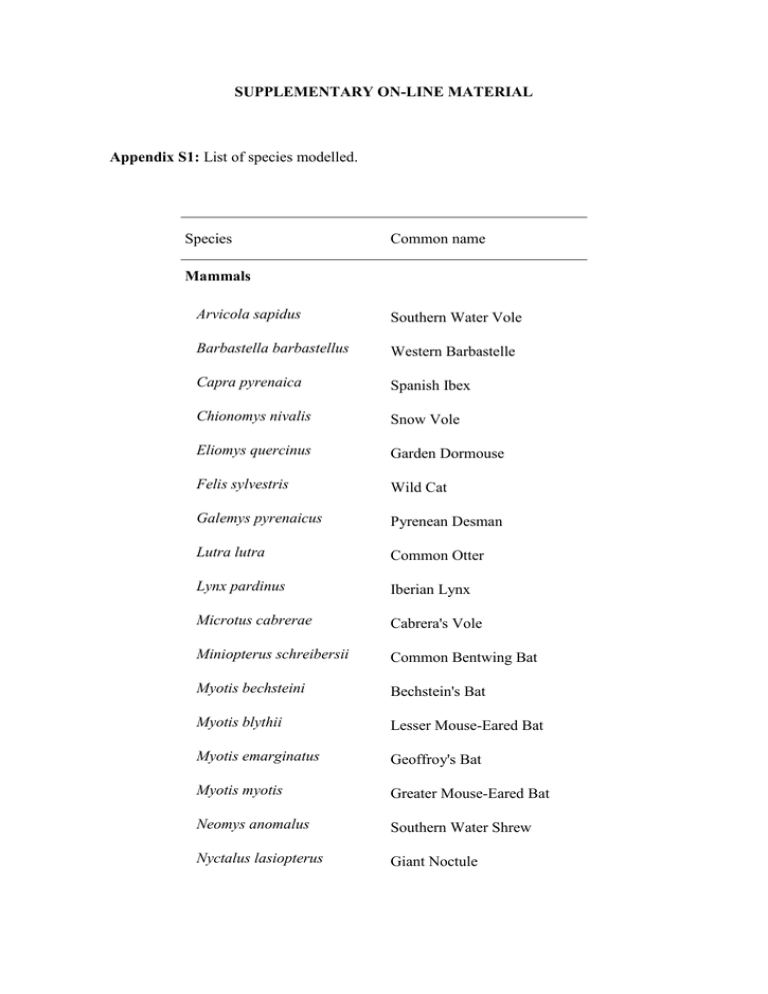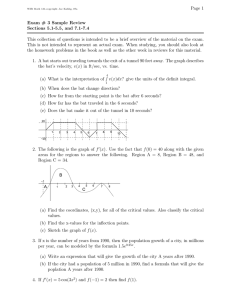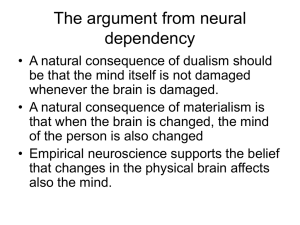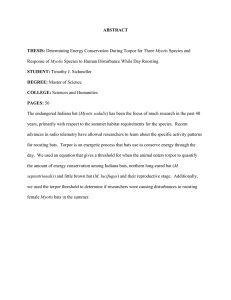Suppl_Material_ACV-07-09-OM-177_Revised.doc
advertisement

SUPPLEMENTARY ON-LINE MATERIAL Appendix S1: List of species modelled. Species Common name Mammals Arvicola sapidus Southern Water Vole Barbastella barbastellus Western Barbastelle Capra pyrenaica Spanish Ibex Chionomys nivalis Snow Vole Eliomys quercinus Garden Dormouse Felis sylvestris Wild Cat Galemys pyrenaicus Pyrenean Desman Lutra lutra Common Otter Lynx pardinus Iberian Lynx Microtus cabrerae Cabrera's Vole Miniopterus schreibersii Common Bentwing Bat Myotis bechsteini Bechstein's Bat Myotis blythii Lesser Mouse-Eared Bat Myotis emarginatus Geoffroy's Bat Myotis myotis Greater Mouse-Eared Bat Neomys anomalus Southern Water Shrew Nyctalus lasiopterus Giant Noctule Nyctalus leisleri Lesser Noctule Plecotus auritus Brown long-eared Bat Plecotus austriacus Grey long-eared Bat Rhinolophus euryale Mediterranean Horseshoe Bat Rhinolophus ferrumequinum Greater Horseshoe Bat Rhinolophus hipposideros Lesser Horseshoe Bat Rhinolophus mehelyi Mehely's Horseshoe Bat Sciurus vulgaris Red Squirrel Birds Actitis hypoleucos Common Sandpiper Aegypius monachus Cinereus Vulture Alcedo atthis Common Kingfisher Anas strepera Gadwall Apus pallidus Pallid Swift Aquila adalberti Spanish Imperial Eagle Aquila chrysaetus Golden Eagle Ardea purpurea Purple Heron Asio flammeus Short-eared Owl Bubo bubo Eurasian Eagle-Owl Burhinus oedicnemus Eurasian Thick-Knee Caprimulgus ruficollis Red-necked nightjars Ciconia ciconia Storks White Stork Ciconia nigra Black Stork Cinclus cinclus White-Throated Dipper Circus aeruginosus Western Marsh Harrier Circaetus gallicus Short-Toed Snake-Eagle Circus pygargus Montagu’s Harrier Coracias garrulous Eurasian Roller Dendrocopos minor Lesser Spotted Woodpecker Egretta garzetta Little Egret Elanus caeruleus Black-winged Kite Emberiza schoeniclus Reed Bunting Falco naumanni Lesser Kestrel Falco peregrinus Peregrine Falcon Falco subbuteo Eurasian Hobby Gyps fulvus Eurasian Griffon Hieraaetus fasciatus Bonelli's Eagle Hieraaetus pennatus Booted Eagle Himantopus himantopus Black-winged Stilt Ixobrychus minutus Little Bittern Jynx torquilla Wryneck Lanius excubitor Great Grey Shrike Luscinia svecica Bluethroat Melanocorypha calandra Calandra Lark Milvus milvus Red Kite Netta rufina Red-crested Pochard Nycticorax nycticorax Black-crowned night-heron Oenanthe leucura Black Wheater Otis tarda Great Bustard Panurus biarmicus Bearded Parrotbill Pernis apivorus Honey Buzzard Phoenicurus phoenicurus Common Redstart Podiceps nigricollis Black-necked Grebe Prunella collaris Alpine Accentor Pterocles alchata Pin-Tailed Sandgrouse Pterocles orientales Black-bellied Sandgrouse Pyrrhocorax pyrrhocorax Red-Billed Chough Rallus aquaticus Water Rail Riparia riparia Sand Martin Saxicola rubetra Whinchat Serinus citrinella Citril Finch Sylvia hortensis Orphean Warbler Tetrax tetrax Little Bustard Tyto alba Barn owl Vanellus vanellus Lapwing Herptiles Hyla arborea Common Tree Frog Rana iberica Iberian Frog Pelodytes punctatus Parsley Frog Alytes cisternasii Iberian Midwife Toad Lissotriton boscai Bosca's newts Triturus pygmaeus Southern Marbled Newt Mesotriton alpestris Alpine Newt Hemorrhois hippocrepis Horseshoe Whip Snake Macroprotodon cucullatus False Smoth Snake Mauremys leprosa Spanish turtle Emys orbicularis European Pond Turtle Lacerta monticola Iberian Rock Lizard Lacerta schreiberi Schreiber's Green Lizard Appendix S2: Generation of pseudo-absences Species distributions are not only constrained by abiotic factors (e.g. climate), but also by biotic interactions, dispersal constrains, anthropogenic effects, stochastic events and other historical, unique and contingent events that may preclude the presence of a given species in a priori environmentally suitable places. Thus, if the goal is to predict environmentally suitable areas (i.e. potential distributions regarding environmental suitability), only absences due to unsuitable environmental conditions (i.e. environmental pseudo-absences) should be used to build predictive models (Peterson, Papes & Soberón, 2008; Jiménez-Valverde, Lobo & Hortal, 2008). Here, pseudoabsences were obtained using multi-dimensional niche envelopes over all peninsular Spain (Lobo, Verdú & Numa, 2006 and references therein), in which presence data were used to calculate an environmental range for each species. Pseudo-absences correspond to the observed absences that lay outside each species’ environmental range (i.e. outside the maximum and minimum for the variables considered). Lastly, both presences and pseudo-absences were included as a binomial dependent variable in GLMs, in order to estimate the potential species’ distributions. GLMs including pseudo-absences generated by the multi-dimensional niche envelope model give predictions closer to the potential species’ distributions (Chefaoui and Lobo, 2008). Assuming that there is not a strong methodological bias in the presence data, as in the present study, this procedure enables to reduce the effect of factors, such as dispersal constraints, that preclude the characterization of the entire species’ potential distribution. Appendix S3: Does the use of pseudo-absences increase inter-model consistency regarding potential distributions? This investigation pursues generating models able to predict species’ potential distributions (i.e. environmentally suitable areas) through space and time, for which we combined observed presences and pseudo-absences under the expectation that pseudoabsences would reduce prediction errors (Chefaoui and Lobo, 2008). To investigate this, we took into account that predictions often vary among different modelling techniques (e.g. Araújo et al., 2005), and assumed that the most robust results should be those that are less dependent on the technique used for modelling. Specifically, we compared the results provided by our General Linear Models (GLMs) when using all observed absences or only pseudo-absences, with the results generated by other two widely employed modelling techniques: Neural Networks (NNTs) and Classification Tree Analyses (TREEs). That is, for each species and technique we obtained two sets of probabilities over all peninsular Spain (modelling either with all absences or only with pseudo-absences), and then examined to what extent the degree of agreement of GLMs with the other models was dependent on the type of data used. Thus, for each species we performed Pearson’s correlations between the obtained probabilities using GLMs and those obtained using the alternative technique (either NNTs or TREEs) for both types of data separately. We compared between the two types of data used, the correlation coefficients obtained for each species. We found that the use of pseudoabsences increased inter-model consistency for the set of species modeled (repeated measures ANOVA; GLM vs. NNT: F1,93 = 42.72, P < 0. 000001; GLM vs. TREE: F1,93 = 104.38, P < 0. 000001; Fig. B). This indeed supports that pseudo-absences give more robust results in this case. Correlation coefficients between two modelization techniques for each species 0.82 0.80 0.78 GLM vs. NNT GLM vs. TREE 0.76 0.74 0.72 0.70 0.68 0.66 0.64 0.62 0.60 0.58 0.56 0.54 All absences Only pseudo-absences Fig. S3 - Pearson correlation coefficients ( X ±SE) between the probabilities obtained using Generalized Linear Models and Neural Networks (GLM vs. NNT: □) or Classification Trees (GLM vs. TREE: ◊), for each species modelled for all of peninsular Spain. Appendix S4: Threshold to transform continuous probabilities into presence/absence data Logistic models generate continuous probabilities of species presences, and a specific threshold is needed to transform the probability data to presence/absence data. Among the different approaches to determine such threshold, we used the prevalence (presence/absence ratio used for modelling), a method that has already been shown to be effective for plants (Liu et al., 2005), aquatic invertebrate families (Manel, Williams & Ormerod, 2001), and simulated species (Jiménez-Valverde and Lobo, 2006). Additionally, we also followed Jiménez-Valverde and Lobo (2006; 2007) to check whether this approach worked well for the case of threatened terrestrial vertebrates analyzed here. We first conducted a jack-knifing resampling technique (Vaughan and Ormerod, 2005; Pearson et al., 2007) to estimate the fractions of correctly predicted presences (sensitivity) and correctly predicted absences (specificity) by our GLM models. The resampling is executed in an iterative way. That is, we excluded one observation at each time and rebuilt the model with the remaining data to predict the response of the excluded observation. Then we re-entered this observation into the dataset and repeated the operation until all observations were predicted. Sensitivity and specificity were computed for each model based on these predictions, and these were used to establish the cut-off level that minimizes model prediction error (i.e. the threshold probability value that minimizes the sensitivity-specificity difference). The correlation between these cut-off level values and species' prevalences was nearly one (Pearson’s correlation: R = 0.960, F1,92 = 1086.09, P < 0.000001; Fig. C), thus supporting prevalence as an appropriate reference to transform model probabilities into predicted presence/absence data. Cut-off minimizing sensitivity-specificity difference 1.0 0.8 0.6 0.4 0.2 0.0 0.0 0.2 0.4 0.6 0.8 1.0 Prevalence Fig. S4 - Relationship between the cut-off that minimized the prediction error (measured as the minimized sensitivity-specificity difference) and prevalence. Appendix S5: Evaluation of models Often, threatened species exhibit low numbers of presences, including some of the species considered in this study, thus preventing to split the data into training and validation datasets. Alternatively, model stability can be estimated by comparing sensitivity and specificity values obtained from direct model predictions with those provided by the jack-knifing resampling technique described above (Vaughan and Ormerod, 2005; Pearson et al., 2007). We also calculated for each model the area under the curve (AUC) of the Receiver Operating Characteristic (ROC) plot of sensitivity against 1-specificity (Fielding and Bell, 1997), in order to use this estimate as an additional index of the overall stability of the models. Specifically, we used simple regressions to perform paired comparisons of the species' values obtained before and after jack-knifing for sensitivity, specificity and AUC. All relationships were strong, positive and highly significant (sensitivity: R = 0.945, F1,92 = 766.47, P < 0. 000001; specificity: R = 0.890, F1,92 = 350.22, P < 0. 000001; AUC: R = 0.751, F1,92 = 118.78, P < 0.000001), thus denoting small overall bias. Additionally, to examine whether there were differences in terms of model stability among animal groups, we took the residuals from the former regressions as measurements of model stability for each species relative to the other species, and then compared them among animal groups using one-way ANOVAs. We only compared the residuals of sensitivity and specificity, since the AUC approach is not recommended to perform among-species accuracy estimations (Lobo, Jiménez-Valverde & Real, 2007). Residuals of sensitivity and specificity did not differ significantly among animal groups (sensitivity: F2,91 = 0.53, P = 0.58; specificity: F2,91= 0.88, P = 0.41), for which we concluded that there were no biases toward any particular taxa. Appendix S6: Spatial autocorrelation It has been shown that the parameter estimation of models is not seriously affected by the spatial autocorrelation in the residuals of models (Hawkins et al., 2007; Diniz-Filho et al., 2007). However, since the aim of our study is to examine differences among animal groups, it is worthwhile to test whether spatial autocorrelation in the residuals of models differs among them. For this purpose we generated spatial correlograms of Moran’s I using the spatial analysis in macroecology (SAM) software (Rangel, DinizFilho & Bini, 2006). Specifically, we identified for each species the maximum distances at which positive spatial autocorrelation remained statistically significant in the data. We then compared among animal groups and found no significant differences (one-way ANOVA: F2,91 = 0.48, P = 0.62). Appendix S7: Range size effect on the proportion of deviance explained by models It has been shown that the fit or performance of models can be associated with species occupancy (Manel et al., 2001; Segurado and Araújo, 2004; Schwartz et al., 2006), therefore we examined this possibility using a Pearson correlation between deviance explained and species occupancy (number of presences). In fact, even the adjusted deviance, weighted by the effective degrees of freedom used to fit the model (Guisan et al., 1999; Engler et al., 2004), significantly correlated with species occupancy (Pearson’s correlation: R = 0.32, F1,92 = 10.67, P < 0.01). Then, we took the residuals of this regression as a measurement of range-corrected deviance to verify that the observed patterns of deviances through functional groups were still the highest for herptiles (oneway ANOVA: F1,91 = 4.52, P = 0.03). Appendix S8: Table S8 - Within-group percentage of species for which a given predictor was retained in the final models after the backward selection procedure (see Methods section). T, mean annual temperature; mPET, minimum potential evapotranspiration; P, annual precipitation; tpAET, Turc-Pike’s actual evapotranspiration; WD, water deficit. Animal Groups Predictors included in models % Mammals % Birds % Herptiles T 68 73.2 76.9 mPET 64 76.7 53.8 T+mPET 80 96.4 100 80 55.3 84.6 tpAET 72 55.3 76.9 WD 92 73.2 69.2 tpAET+WD 96 91 100 Acidic deposits 52 35.7 46.1 Basic deposits 44 46.4 23.1 Acidic rocks 48 44.6 53.8 Basic rocks 44 37.5 46.1 Average elevation 48 51.7 53.8 Range of elevation 40 69.6 53.8 Temperature-related predictors Water-related predictors P Temperature- and water-related predictors Soil predictors Topographical predictors Additional references: Araújo, M.B., Pearson, R.G., Thuiller, W. & Erhard, M. (2005). Validation of speciesclimate impact models under climate change. Glob. Change Biol. 11, 1504-1513. Chefaoui, R.M. & Lobo, J.M. (2008). Assessing the effects of pseudo-absences on predictive distribution model performance. Ecol. Model. 210, 478-486. Diniz-Filho, J.A.F., Hawkins, B.A., Bini, L.M., De Marco, P. & Blackburn, T.M. (2007). Are spatial regression methods a panacea or a Pandora’s box? A reply to Beale et al. (2007). Ecography 30, 848-851. Fielding, A.H. & Bell, J.F. (1997). A review of methods for the assessment of prediction errors in conservation presence/ absence models. Environ. Conserv. 24, 38-49. Hawkins, B.A., Diniz-Filho, J.A.F., Bini, L.M., De Marco, P. & Blackburn, T.M. (2007). Red herrings revisited: spatial autocorrelation and parameter estimation in geographical ecology. Ecography 30, 375-384. Jiménez-Valverde, A., Lobo, J.M. & Hortal, J. (2008). Not as good as they seem: the importance of concepts in species distribution modelling. Divers. Distrib. 24, 885-890. Lobo, J.M., Verdú, J.R. & Numa, C. (2006). Environmental and geographical factors affecting the Iberian distribution of flightless Jekelius species (Coleoptera: Geotrupidae). Divers. Distrib. 12, 179-188. Lobo, J.M., Jiménez-Valverde, A. & Real, R. (2007). AUC: a misleading measure of the performance of predictive distribution models. Global Ecol. Biogeogr. 17, 145–151. Manel, S., Williams, H.C. & Ormerod, S.J. (2001). Evaluating presence-absence models in ecology: the need to account for prevalence. J. Appl. Ecol. 38, 921-931. Peterson, A.T., Papes, M. & Soberón, J. (2008). Rethinking receiver operating characteristic analysis applications in ecological niche modelling. Ecol. Model. 213, 63-72. Rangel, T.F.L.V.B., Diniz-Filho, J.A.F. & Bini, L.M. (2006). Towards an integrated computational tool for spatial analysis in macroecology and biogeography. Global Ecol. Biogeogr. 15, 321-327. Schwartz, M.W., Iverson, L.R., Prasad, A.M., Matthews, S.N. & O’Connor, R.J. (2006). Predicting extinctions as a result of climate change. Ecology 87, 1611-1615. Segurado, P. & Araújo, M.B. (2004). An evaluation of methods for modelling species distributions. J. Biogeogr. 31, 1555-1568. Vaughan, I.P. & Ormerod, S.J. (2005). The continuing challenges of testing species distribution models. J. Appl. Ecol. 42, 720-730.








